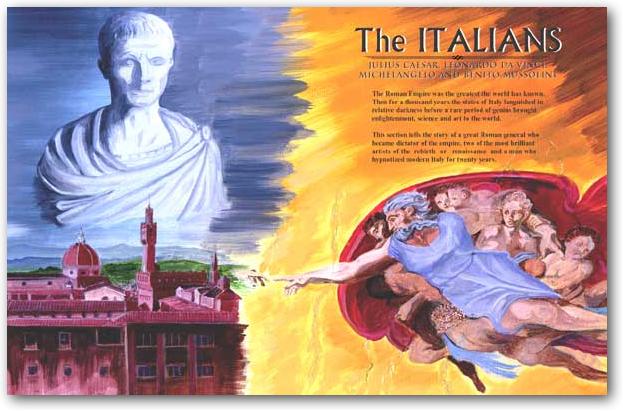| |
THE ITALIANSJulius Caesar | Leonardo da Vinci | Michelangelo | Benito Mussolini The Roman Empire was the greatest the world has known. Then for a thousand years the states of Italy languished in relative darkness before a rare period of genius brought enlightenment, science and art to the world. This section tells the story of a great Roman general who became dictator of the empire, two of the most brilliant artists of the “rebirth” or “renaissance” and a man who hypnotized modern Italy for twenty years.
INTRODUCTIONFew countries have given us so much, for as long, as has Italy. Yet, strictly speaking, there was no “Italy” until about a hundred and fifty years ago — but more about that later. Let’s think about what has come out of this boot-shaped land… Some of the world’s loveliest buildings, music, paintings, sculpture, not to mention its food, wine, language, laws, clothing, highways and the Ferrari sports cars that grace them. The world (especially the USA) has benefited from Italian immigration and laughed, cheered and cried, at and with, its colorful personalities. From its capital, Rome, which is still the center of the Catholic Church, came perhaps the world’s greatest civilization — The Roman Empire. BACKGROUNDThe first civilization in the Italian peninsular was that of the Etruscans who are believed to have come from what is now Turkey, in about 1200 BCE. They dominated Northern Italy (which is still called Tuscany). About 800 BCE the Greeks and Phoenicians (now Lebanese) were in southern Italy. Another tribe, the Latins, dominated the region around the Tiber River in the middle of the country. It was these Latins who first built Rome on seven hills, about 500 BCE. They had no kings, but ran the first republic with elected officials. There were three classes of people. At the top the nobles and landowners (patricians), in the middle the common people or plebians (plebes) and at the bottom, the slaves who had virtually no rights and could neither vote nor fight for their country. By 272 BCE the Latins (or Romans) had defeated the Etruscans and had copied many of the ways of the Greeks, including their belief in multiple gods. The most serious threat to their dominance came from the Phoenician port across the Mediterranean in Carthage on the African coast. The Romans at that time had no navy and the Mediterranean was dominated by Carthaginian businessmen and their powerful navy. In fact Spain and parts of France were Carthaginian possessions. War broke out between Rome and Carthage and this first Punic War lasted 24 years. During this time the Romans improved their navy by copying the Carthaginian vessels. They also figured out a better fighting ship which carried a boarding bridge. HANNIBAL AND ELEPHANTSThen for 23 years there was peace, until the winter of 218 BCE when wild mountain people from the Alps started arriving in Rome. With panic in their eyes and their lips trembling, they told of thousands of brown warriors with strange beasts ‘each as big as a house’ who had emerged from the mountain passes. What they had witnessed was a classic military maneuver carried out by one of the world’s greatest generals — Hannibal (247-183 BCE) With 90,000 soldiers, 12,000 cavalry and 37 fighting elephants he had crossed the mighty Alps. Many soldiers died in this incredible march, which started in Spain and finished as an occupying force in Italy. By outwitting and out-generaling the Romans, Hannibal spent the next 13 years as master of the Italian peninsular. The only portion he never conquered was the city of Rome itself. Eventually worn out by Roman guerrilla tactics, lack of reinforcements and home- sickness he returned to Carthage only to be defeated there by the Romans. He fled to Asia where he committed suicide. Rome later burnt Carthage to the ground and plowed over the ground where it had once stood, scattering salt, so that nothing would grow. With Carthage gone forever, Rome turned its eyes east and conquered Greece and Syria. As it became more powerful, it refined its parliamentary and legal system. “The Republic of Rome” meant there were no kings. In their place were two consuls elected each year by the Senate. The people’s rights were protected. Key elements of Rome’s strength were:
| ||
